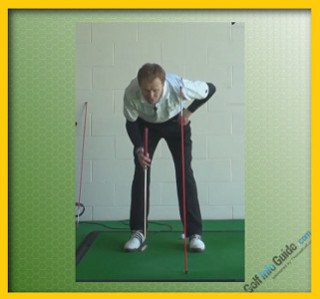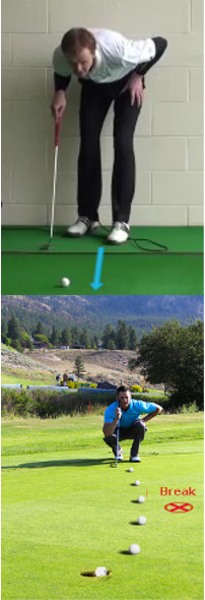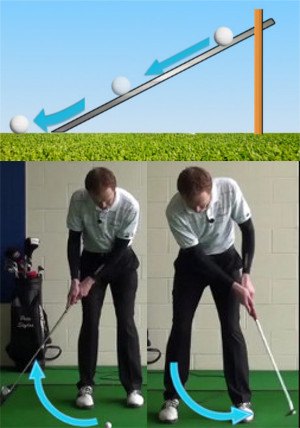
In every round of golf, many putts of all sorts of different lengths will be faced. Most of those putts break or curve from one direction to the other. A breaking putt can range from a short, must make putt, to a long, lag it up close putt, but nearly all of them mean that the golfer has to contend with predicting the ball rolling down a hill of some sort.
What needs to be remembered as golfers is that it is only ever possible to produce a putting stroke that is able to hit the golf ball in a straight line. It is impossible to hit a putt from left to right or right to left. Therefore, there is a need to imagine how the ball will roll down the hill on a green and into the hole. The best and first thought a golfer should ever have on a green is 'if I hit this putt straight at the hole will it go in?' Most of the time the answer to this question will be 'no'. In which case, there is a decision to be made as to what direction the ball will move towards the hole and then a need to pick a different target other than the hole. This is a tricky skill to master and so here we have a few things to think about and a drill to use with a set of tour sticks to help practice breaking putts.

Firstly, when on the green, look at where the ball will roll down the hill and enter the hole. Will it roll in from the front, the side or nearer the back of the hole? Now work backwards from there, deciding where a straight putt would need to be hit to be able to get the ball to roll down the hill into that part of the hole. At this point, look for the apex or the highest point of the putt. At the apex of the putt, put one of the tour sticks in the ground, pointing vertically upwards, to use as the aim point. Then, put the second tour stick on the ground, parallel to the apex of the marker stick, to allow correct alignment of the feet and body to the apex of the putt, and not the hole.
Remember, only a straight putt can be hit, so there is a need to focus on a particular point on the green and not the hole, which at the moment is the tour stick. The objective is to roll the putt just outside of the vertical tour stick with the correct pace, so that the ball rolls around the stick, past the apex of the putt, and breaks down the hill, rolling into the hole.
Using the tour sticks in this way, with different types of putts, will give a strong visual image of how different putts can break. It will help you to practice reading greens and trusting the line of the putt that is picked, to be more successful on the greens.

How to Hole More Breaking Putts on the Greens
Everyone would like to make more putts. Obviously, making more putts means shooting lower scores. Unfortunately, for many amateur golfers, putting remains the most difficult part of the game – so those extra holed putts can be hard to come by. No matter what level of player you are currently, you could quickly lower your average score (and your handicap) if you were able to knock in even a couple more putts per round.
When most golfers start to think about how they could make more putts, they automatically turn their attention to the stroke itself. Your putting stroke is what sends the ball on the way toward the hole, so improving the quality of that motion should lead to more makes – right? Well, maybe. While an improved stroke can't hurt your chances of making more putts, there is more to knocking them in than just making a good stroke. You also need to have a good read, especially on breaking putts, and you have to have the correct speed to match up with that read. Flat putts are relatively rare in golf, so the ability to hole out breaking putts is what is going to determine exactly how well you are able to perform on the course.
In the content below, we are going to look at the ins and outs of how to make more breaking putts. We aren't going to focus on the stroke itself with the instruction below – instead, we are going to look at how you can improve both your reads and your speed control in order to allow the ball to find the bottom of the cup more often. Professional golfers often make the task of holing breaking putts look quite easy, but you probably know better. Knocking in a tough, side-hill putt is one of the biggest challenges in the game, but you can conquer that challenge more often if you know exactly how to approach this type of shot.
Before going further, it should be mentioned that you will always prefer to have a straight putt whenever possible. If you are chipping, for example, look for a flat spot around the hole where you can position your ball to make the upcoming putt as easy as possible. It is certainly possible to improve your performance on breaking putts – and that is what you are going to try to do with the help of the content below – but a breaking putt is always going to be more difficult to make than a straight one. In terms of course management and general strategy, doing your best to locate straight putts is going to pay off for you in the long run. However, they aren't all going to be straight, so preparing yourself to deal with the breaking one is a great idea.
All of the instruction below is based on a right handed golfer. If you happen to play (or, at least, putt) left handed, please take a moment to reverse the directions as necessary.

The Relationship Between Line and Speed
The biggest challenge when trying to hole a breaking putt doesn't come with needing to pick out the correct line – it comes with having to match that line to the right speed. The line that you are going to use on breaking putts is completely dependent on the speed that you intend to hit the ball. If you are going to hit the ball on the harder side, you can play less break, while putts that are hit softer are going to require more break. It is the ability to tie together the line and the speed perfectly that will determine how many breaking putts you are able to hole.
As you read your putts, you must constantly be thinking about the speed that you intend to use. It is simply impossible to pick a good line without also picking a speed. This is a point that most amateur golfers don't understand – and they fail to read greens correctly as a result. If you are looking at a putt that breaks from right to left, for example, you can't decide how far right to aim until you decide how much speed to use. You might need to play the ball a foot out to the right if you are going to give it barely enough speed to reach the cup, but you may only need to be six inches out if you are going to run it a couple feet past. So, as you stand behind the ball to get a read, it is essential that you keep speed constantly at the front of your mind as you assess the slope between your ball and the cup.
Rather than changing your approach to the speed of your putts from green to green, you should have a 'standard' method that you use on every putt you face. This method will be related to your overall playing style, and even your personality. On this point, there are really two categories of golfers – those who like to hit their putts with just enough speed to reach the hole, and those who like to putt aggressively. Each option is highlighted below -
- Conservative speed. Those who putt with conservative speed tend to play the same way around the rest of the course. If you are a player who likes to put a premium on control over distance with your full swing, and you usually play away from hazards whenever possible, you will likely be best-served by a conservative approach to your putting speed. Of course, the benefit of this method is the fact that you should be able to leave yourself with short second putts if you execute the first putt correctly. Players who use conservative speed often have tap in putts left for their second, which is a great way to keep stress out of your game. The obvious downside of this method is that you might leave putts short from time to time – and a putt that is left short has no chance to go in. In order to make this your standard approach to putting, you need to tell yourself that you are okay with the occasional putt coming up short of the hole.
- Aggressive speed. Some players prefer to charge the ball at the hole, running it two or three feet past the cup (if it doesn't fall in). This is the putting style which will be prefer by players who are always trying to force the action – if you hit a lot of drivers and always aim at the flag, for instance, aggressive putting will likely serve you well. There are a couple of benefits to this type of putting, with the most obvious being that you are unlikely to come up short of the hole. Each putt you hit should get at least to the hole, so you will have a chance to make every one. Also, since the ball is carrying more speed to the hole, you will need to play less break than if you used less speed. The negative side of this picture is the fact that you are going to have plenty of three foot putts to clean up throughout the day. Only players who are comfortable and confident over short putts should consider taking this approach on the greens.
The best way to decide on the speed that you will use on your putts is to test out both options on the practice green. Spend some time putting both ways to see which option leads to the best results. There are quality putters who fall into both camps on this point, so it is certainly possible to have good results either way you go.

How to Read a Breaking Putt
Once you have settled on your general approach to putting, you can then move on to learning how you are going to go about reading the slope of the greens. This is a skill that is somewhat difficult to teach, as only you can know what you are seeing through your eyes. However, there are a few points to understand which can help anyone make better reads on a consistent basis. Use the tips below to make accurate reads and give yourself the best possible chance to knock the ball into the cup.
- Read from both sides. The first key to getting a good read is giving yourself a look at the putt from all angles. Specifically, you want to be sure that you are viewing your putt from both behind the hole and behind the ball. It might take an extra moment, and a bit of extra effort, to walk around the putt and see it from both sides, but that effort is worth it. You will see different things from each side, and it is your job to bring those two reads together in order to come up with your final read. As a general rule, you should use the behind-the-hole view to read the end of the putt, while the read you get from behind the ball will help you on the first few feet of the roll.
- Take in the big picture. You don't want to read your putts with a narrow focus by only looking at the ground between your ball and the cup. Instead, think big picture and look at the tilt of the green as a whole. To help you figure out which way the green is sloped, try to figure out where water would drain off of the putting surface during a heavy rain. Nearly every green you will play has been designed in a way that can drain water, and obviously, that water is always going to flow downhill. Once you spot the drainage plan on the green, you should have a much better idea of which way your ball is going to curve as it rolls toward the cup.
- Read the putting green. Do you ever take time to read your putts on the practice green? If not, you are missing a great opportunity to learn about the putting surfaces that you will be dealing with for the day. Every course has patterns within the greens that you need to learn in order to be successful, and you can start to learn those patterns before the round starts. For example, some courses have greens that break more than you would think, while others will break less. Take time to read some putts on the practice green, and then hit the putts, so you can make adjustments before playing the first hole.
- Play more break. Generally speaking, amateur golfers rarely play enough break on their side hill putts. To find out if this applies to you, try tracking your putting results over the next few rounds. Each time you face the breaking putts, make a note of whether you missed that putt on the high side or the low side (don't make a note if you actually make the putt). When you miss on the low side, it means you have not played enough break for the speed that was used. After a few rounds have gone by, add up the results and look for a pattern in your putting. If you are regularly missing on the low side, you need to play more break in your reads. Gradually add to your reads until you are playing enough break to give the ball a chance to fall in.
While the points on the list above should help you make better reads, the single most important piece of this puzzle is simply practice. There is no replacement for experience in reading greens, so you need to get out to the practice green and work on this skill. Just like anything else in golf, you should get better and better at reading your breaking putts over time. Each putt you hit goes into your memory bank, and you can draw on that experience going forward. As the experience adds up, you will understand your own putting style better and better, and you should be able to look forward to more holed putts.

Uphill vs. Downhill Putts
As you should already know, there is a big difference between putting uphill and putting downhill. When you putt uphill, you can be aggressive because you don't have to worry about the ball rolling several feet past the cup if you happen to miss. On the other hand, when putting downhill, you are forced to roll the ball defensively in an effort to keep it near the hole for your next putt. When given the choice, nearly every golfer would prefer to putt uphill as opposed to downhill, but it is likely that you will face both situations during every round that you play.
So, what are the differences between putting uphill and downhill when it comes to breaking putts? The first, and most important, point is the fact that you will have to play less break when putting uphill. When putting uphill, you are obviously going to hit the ball harder, so it will have less time to take the break that is present in the putt. On a downhill putt, the roll will be slower, so there will be more time spent between the time you strike the putt and the time it stops – and that means more break. The bottom line is this – when putting downhill, you will need to play significantly more break than when putting uphill. Amateur golfers (and even some professionals) regularly under-read their downhill putts, so keep that in mind and play as much break as possible when coming down the slope.
There is another reason to play a lot of break when coming down the hill, and it relates to speed control. When putting downhill, you want to make sure you keep your speed under control to avoid setting up a long come back putt, and the best way to do that is to play plenty of break. If you play a straighter line, the putt is going to have to be hit harder – meaning you will run the risk of racing the ball past the cup. It might be okay to putt to way from time to time when you really want to make a putt, but for the majority of the time, playing plenty of break and using careful speed is going to be the right approach downhill.
It should be obvious by now that you would prefer to be putting uphill if at all possible, because of the fact that you will need to play less break and can be more aggressive. Professional golfers always play to the low side when possible to allow for this aggressive style of putting, and you should do the same when you can. When you are standing in the fairway facing an approach shot, or on the tee of a par three, you should figure out which side of the green is the low side and favor it with your target line. Of course you aren't going to successfully hit that low side every time, but even doing so more often than not is going to benefit you in the long run.

It's Not Make or Break
Believe it or not, one of the keys to making more breaking putts is actually understanding that you don't have to make every putt you look at throughout the day. Realistically you aren't ever going to make a high percentage of your breaking putts, even if you are doing everything right. It is difficult to make even one breaking putt, so you don't want to expect to knock them in time after time.
This mindset can help your performance on the greens because it will free you up to make your best stroke as often as possible. You don't need to be fearful of missing – it is okay to miss. The key to successful performance on breaking putts over the long run is to simply get the speed right. When you use the right speed and you get near the proper line, you will leave the ball close enough to the cup for a tap in second. Really, that should be your goal when standing over a putt with a significant break – to have an easy second putt. If you can two putt every one of your breaking putts throughout a round, and maybe make one from time to time along the way, you will be very happy with your performance on the greens.
This kind of attitude can actually help you play better in all aspects of the green. You certainly want to try your best, and you want to play well, but you don't want to force the action. You can only control so much on the golf course, and trying to control things beyond your reach is a bad idea. As long as you think carefully about each shot you hit, and you then execute your technique to the best of your ability, you should be proud of your game. Somedays the score will add up to a better score than others, but your focus should always be on the process. Get the process right, and the results will usually speak for themselves.
Dealing with breaking putts is always going to be a challenge. Slope is added to greens to make them more interesting and more challenging, and that is exactly what it does. If you are able to use the advice contained above, you should be able to improve your performance on difficult breaking putts in the near future. As with anything else, you are going to need to practice your putting over sloped surfaces, so make sure to put this portion of the game on your to-do list right away. With a good plan in mind and plenty of practice under your belt, dealing with breaking putts suddenly won't seem like the daunting task that you once thought it was.






